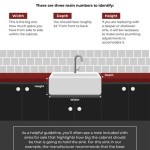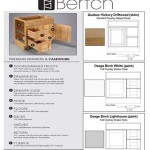```html
Kitchen Cabinet Sink: Selection, Installation, and Maintenance
The kitchen sink is an integral component of any culinary space, serving as a central hub for food preparation, cleaning, and general utility. Selecting the appropriate kitchen cabinet sink, ensuring proper installation, and implementing a consistent maintenance routine are crucial for optimizing functionality and longevity. This article will delve into various aspects of kitchen cabinet sinks, encompassing material choices, installation procedures, and preventative maintenance strategies.
Understanding Kitchen Cabinet Sink Types
Kitchen cabinet sinks are available in a diverse range of configurations, each designed to accommodate specific needs and aesthetic preferences. The primary sink types include drop-in (also known as top-mount), undermount, farmhouse (also known as apron-front), and dual-bowl sinks. Each type presents unique installation requirements and visual characteristics.
Drop-in Sinks: Drop-in sinks, characterized by their prominent lip or rim that rests on the countertop, are relatively straightforward to install. They are suitable for a wide variety of countertop materials and represent a cost-effective option. The exposed rim can, however, accumulate debris and require more frequent cleaning.
Undermount Sinks: Undermount sinks are installed beneath the countertop, creating a seamless transition between the sink basin and the surrounding surface. This design promotes hygiene and simplifies countertop cleaning. Undermount sinks typically require precise countertop fabrication and are generally more expensive to install than drop-in models. The countertop material must be capable of supporting the weight of the sink and its contents.
Farmhouse Sinks: Farmhouse sinks, distinguished by their exposed front apron, evoke a traditional aesthetic. These sinks are often larger and deeper than standard models, providing ample space for washing large pots and pans. The installation of a farmhouse sink typically involves modifications to the existing cabinet structure to accommodate the sink's dimensions.
Dual-Bowl Sinks: Dual-bowl sinks incorporate two separate basins, offering increased versatility for multitasking. One basin can be used for washing, while the other can be used for rinsing or food disposal. Dual-bowl sinks are available in various configurations, including equal-sized basins and configurations with one larger and one smaller basin.
Selecting Appropriate Sink Materials
The material composition of a kitchen cabinet sink directly influences its durability, aesthetic appeal, and resistance to staining and scratching. Common sink materials include stainless steel, cast iron, granite composite, and fireclay. Each material possesses distinct advantages and disadvantages.
Stainless Steel: Stainless steel sinks are renowned for their durability, resistance to corrosion, and ease of maintenance. They are available in a range of gauges, with lower gauge numbers indicating thicker and more durable steel. Choose a stainless steel sink with a sound-deadening coating to minimize noise during use. It is important to note that stainless steel can be susceptible to water spots and scratches, but these are usually superficial and can be addressed with appropriate cleaning products.
Cast Iron: Cast iron sinks are constructed from a base of cast iron coated with a layer of enamel. This enamel coating provides a durable, non-porous surface that is resistant to staining and scratching. Cast iron sinks are typically heavier than stainless steel sinks and require substantial cabinet support. While durable, the enamel coating can chip or crack if subjected to significant impact.
Granite Composite: Granite composite sinks are manufactured from a blend of granite stone dust and acrylic resins. This combination yields a sink that is exceptionally durable, heat-resistant, and resistant to staining and scratching. Granite composite sinks are available in a variety of colors and textures, allowing for seamless integration with diverse kitchen designs. They are typically more expensive than stainless steel sinks but offer superior performance and aesthetics.
Fireclay: Fireclay sinks are crafted from clay that is fired at extremely high temperatures, resulting in a dense, non-porous material. Fireclay sinks are highly resistant to chipping, scratching, and staining. They offer a classic, elegant aesthetic and are commonly used in farmhouse-style kitchens. Fireclay sinks are typically heavy and require professional installation.
Installation Procedures for Kitchen Cabinet Sinks
The installation process for a kitchen cabinet sink varies depending on the sink type and the existing plumbing configuration. While some homeowners may opt for DIY installation, professional installation is recommended to ensure proper sealing, plumbing connections, and cabinet support. Incorrect installation can lead to leaks, water damage, and structural issues.
Preparation: Before commencing the installation, it is essential to turn off the water supply to the sink. The existing sink and plumbing fixtures must be disconnected and removed. The countertop opening must be clean and free of debris. Ensure that the new sink is compatible with the existing countertop opening or that the countertop opening is modified to accommodate the new sink.
Drop-in Sink Installation: For drop-in sinks, apply a bead of plumber's putty or silicone sealant around the perimeter of the countertop opening. Carefully lower the sink into the opening, pressing down firmly to create a watertight seal. Secure the sink to the countertop using the provided mounting clips.
Undermount Sink Installation: Undermount sinks require the installation of mounting brackets or clips to support the sink from beneath the countertop. Apply a bead of silicone sealant around the rim of the sink and carefully position it beneath the countertop. Secure the sink to the countertop using the mounting brackets or clips. Allow the sealant to cure completely before connecting the plumbing.
Plumbing Connections: Connect the drain assembly to the sink drain outlet. Install the faucet and spray hose according to the manufacturer's instructions. Connect the water supply lines to the faucet, ensuring that the hot and cold water lines are properly identified and connected. Inspect all plumbing connections for leaks before restoring the water supply.
Maintaining Kitchen Cabinet Sinks
Regular maintenance is crucial for preserving the appearance and functionality of a kitchen cabinet sink. Proper cleaning techniques and preventative measures can prevent staining, corrosion, and other forms of damage.
Daily Cleaning: Rinse the sink thoroughly with water after each use to remove food particles and debris. Use a mild dish soap and a soft sponge or cloth to clean the sink surface. Avoid using abrasive cleaners or scouring pads, as these can scratch the sink surface. Pay particular attention to areas around the drain and faucet, where build-up is more likely to occur.
Stain Removal: For stubborn stains, use a specialized sink cleaner appropriate for the sink material. Baking soda paste can be used to remove mild stains from stainless steel and cast iron sinks. For hard water stains, use a solution of equal parts white vinegar and water. Always test cleaning solutions in an inconspicuous area before applying them to the entire sink surface. Rinse thoroughly after cleaning.
Preventing Clogs: Avoid pouring grease, oil, or food scraps down the sink drain. Use a strainer to catch food particles and debris. Flush the drain regularly with hot water to prevent the build-up of grease and other substances. Consider using a drain cleaner periodically to prevent clogs.
Protecting the Sink Surface: Use a sink grid or mat to protect the sink surface from scratches and dents. Avoid placing heavy objects directly into the sink. When washing sharp objects, such as knives, take care not to scratch the sink surface. Regularly inspect the sink for any signs of damage, such as chips or cracks, and address them promptly to prevent further deterioration.
Addressing Common Sink Problems
Even with proper maintenance, kitchen cabinet sinks may experience occasional problems, such as leaks, clogs, and corrosion. Addressing these problems promptly can prevent further damage and extend the life of the sink.
Leaks: Leaks can occur around the drain, faucet, or water supply lines. Tighten loose connections and replace worn washers or O-rings. If the leak persists, consult a professional plumber.
Clogs: Clogs can occur in the drainpipe or P-trap. Use a plunger to dislodge the clog. If the plunger is ineffective, use a drain snake or remove the P-trap to clear the obstruction. In severe cases, a professional plumber may be required.
Corrosion: Corrosion can occur on stainless steel sinks, particularly in areas with hard water. Use a stainless steel cleaner and polish to remove corrosion and protect the sink surface. Consider installing a water softener to reduce the mineral content of the water.
```
Hampton Bay Shaker 36 In W X 24 D 34 5 H Assembled Sink Base Kitchen Cabinet Dove Gray Ksb36 Sdv The Home Depot

Types Of Kitchen Sinks The Home Depot

How To Replace A Kitchen Sink Base Cabinet Vevano

Hampton Bay Easthaven Assembled 30x34 5x24 In Frameless Sink Base Cabinet With False Drawer Front Unfinished Beech Eh3035s Gb The Home Depot

Hampton Bay Shaker 36 In W X 24 D 34 5 H Assembled Sink Base Kitchen Cabinet Satin White Ksb36 Ssw The Home Depot

How To Choose A Kitchen Sink Capitol Kitchens And Baths

Hampton Bay 60 In W X 24 D 34 5 H Assembled Sink Base Kitchen Cabinet Unfinished With Recessed Panel Ksbf60 Uf The Home Depot

Freestanding Kitchen Sink Cupboard

How To Choose A Kitchen Sink Capitol Kitchens And Baths

Diamond At Appliance Cabinets Country Sink Base








